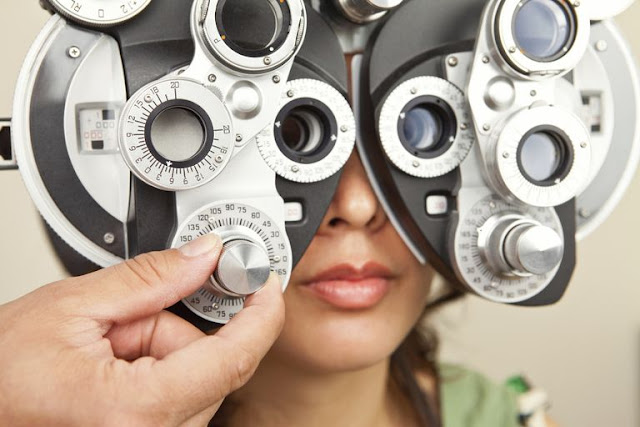Refraction is a process your eye care professional uses to measure your refractive error, or vision problem.
What Is a Refractive Error?
A refractive error is an optical defect that does not allow light to be brought into sharp focus on your retina, resulting in blurred or distorted vision. Examples of refractive error are myopia, hyperopia, and astigmatism.
What Does a Comprehensive Eye Exam Include?
During a comprehensive eye examination, your doctor uses refraction to determine how much power is needed to bring your eyes to normal, perfectly focused vision.
Your doctor will decide if glasses, contact lenses or laser vision correction will yield you the most clear eyesight. Refraction consists of two parts, objective and subjective.
Objective Refraction
An objective refraction is a refraction obtained without receiving any feedback from the patient. An objective refraction is obtained by using different instruments. Your doctor will use a retinoscope or auto-refractor to measure your refraction without asking for subjective responses from you.
- Retinoscopy: One of the most common instruments used for objective refraction is the retinoscope. Using a retinoscope, your doctor will project a streak of light into your pupil. A series of lenses are flashed in front of your eye. By looking through the retinoscope, your doctor can study the light reflex of the pupil. Based on the movement and orientation of this retinal reflection, the refractive state of your eye is measured.
- Auto-refraction: Another instrument used for objective refraction is an auto-refractor. An auto-refractor is a computerized instrument that shines light into your eye. The light travels through the front part of your eye to the back part of your eye, then back again. The information bounces back to the instrument, giving an objective measurement of your refractive error. Auto-refractors are quick and easy to use, and require no feedback from you.
Subjective Refraction
A subjective refraction requires responses from the patient. Your doctor may use a phoropter to measure your subjective refractive error to determine your eyeglass prescription. Typically, you will sit behind the phoropter and look at an eye chart. Your doctor will change lenses and other settings while asking you for feedback on which settings give you the best vision.Cyclopegic Refraction
Sometimes eye doctors prefer to obtain a cycloplegic refraction, especially when trying to obtain an accurate refraction in young children who may skew refraction measurements by adjusting their eyes. Cycloplegic eye drops are applied to the eye to temporarily paralyze the ciliary muscle of the eye.There are three main types of patients for whom doctors like to perform a cycloplegic refraction:- Children: Children tend to focus at a close range and are unable to control focusing when asked to look at a far distance during an examination. A doctor can be confident they are measuring the full prescription when performing a cycloplegic refraction.
- Adults experiencing pre-presbyopia: Presbyopia is the condition that affects the ability to focus on near objects, mostly occurring in people over age 40. Some people, however, experience pre-presbyopia in which they are unable to focus quickly from near to distance and back, and can cause night-time driving symptoms as well. The best way to identify the problem is through a cycloplegic refraction.
- LASIK: Candidates for laser vision correction or other refractive surgery must undergo a cycloplegic refraction so the surgeon will know exactly how much of the vision problem needs to be corrected with the laser.
Our experienced eye doctors offer comprehensive vision examinations at our Houston optometry office and specialize in the diagnosis and treatment of a wide array of eye diseases, conditions, and problems. We use advanced diagnostic technology and vision correction products and are committed to improving the quality of life of persons in the Houston community through enhanced vision. Give yourself the gift of clear vision – schedule an appointment with your eye care provider today.

No comments:
Post a Comment